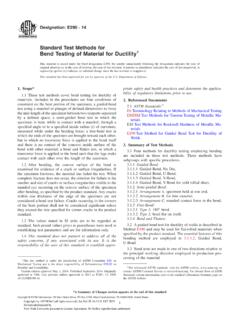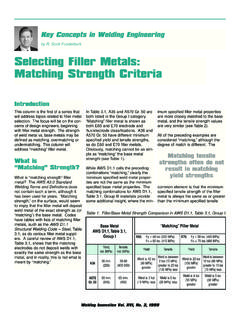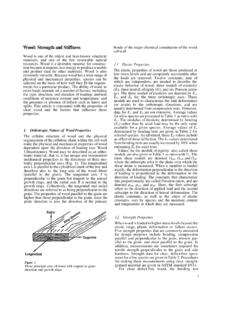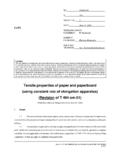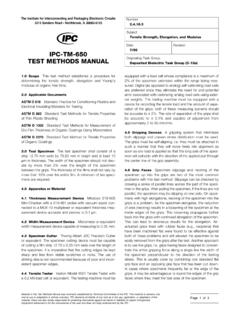Transcription of Standard Test Method for Tensile Properties of Polymer ...
1 Designation: D3039/D3039M 14 Standard Test Method forTensile Properties of Polymer Matrix Composite Materials1 This Standard is issued under the fixed designation D3039/D3039M; the number immediately following the designation indicates theyear of original adoption or, in the case of revision, the year of last revision. A number in parentheses indicates the year of lastreapproval. A superscript epsilon ( ) indicates an editorial change since the last revision or Standard has been approved for use by agencies of the Department of This test Method determines the in-plane Tensile prop-erties of Polymer matrix composite materials reinforced byhigh-modulus fibers.
2 The composite material forms are limitedto continuous fiber or discontinuous fiber-reinforced compos-ites in which the laminate is balanced and symmetric withrespect to the test The values stated in either SI units or inch-pound unitsare to be regarded separately as Standard . Within the text, theinch-pound units are shown in brackets. The values stated ineach system are not exact equivalents; therefore, each systemmust be used independently of the other. Combining valuesfrom the two systems may result in nonconformance with Standard does not purport to address all of thesafety concerns, if any, associated with its use. It is theresponsibility of the user of this Standard to establish appro-priate safety and health practices and determine the applica-bility of regulatory limitations prior to Referenced Standards.
3 2D792 Test Methods for Density and Specific Gravity (Rela-tive Density) of Plastics by DisplacementD883 Terminology Relating to PlasticsD2584 Test Method for Ignition Loss of Cured ReinforcedResinsD2734 Test Methods for Void Content of Reinforced PlasticsD3171 Test Methods for Constituent Content of CompositeMaterialsD3878 Terminology for Composite MaterialsD5229/D5229 MTest Method for Moisture Absorption Prop-erties and Equilibrium Conditioning of Polymer MatrixComposite MaterialsE4 Practices for Force Verification of Testing MachinesE6 Terminology Relating to Methods of Mechanical TestingE83 Practice for Verification and Classification of Exten-someter SystemsE111 Test Method for Young s
4 Modulus, Tangent Modulus,and Chord ModulusE122 Practice for Calculating Sample Size to Estimate, WithSpecified Precision, the Average for a Characteristic of aLot or ProcessE132 Test Method for Poisson s Ratio at Room TemperatureE177 Practice for Use of the Terms Precision and Bias inASTM Test MethodsE251 Test Methods for Performance Characteristics of Me-tallic Bonded Resistance Strain GaugesE456 Terminology Relating to Quality and StatisticsE1012 Practice for Verification of Testing Frame and Speci-men Alignment Under Tensile and Compressive AxialForce ApplicationE1237 Guide for Installing Bonded Resistance Strain Gages3. TerminologyD3878defines terms relatingto high-modulus fibers and their composites.
5 TerminologyD883defines terms relating to plastics. TerminologyE6definesterms relating to mechanical testing. TerminologyE456andPracticeE177define terms relating to statistics. In the event ofa conflict between terms, TerminologyD3878shall haveprecedence over the other of Terms Specific to This If the term represents a physical quantity, itsanalytical dimensions are stated immediately following theterm (or letter symbol) in fundamental dimension form, usingthe following ASTM Standard symbology for fundamentaldimensions, shown within square brackets: [M] for mass, [L]for length, [T] for time, [ ] for thermodynamic temperature,and [nd] for nondimensional quantities.
6 Use of these symbolsis restricted to analytical dimensions when used with squarebrackets, as the symbols may have other definitions when usedwithout the test Method is under the jurisdiction of ASTM CommitteeD30onComposite Materials and is the direct responsibility of and Laminate Test edition approved May 15, 2014. Published May 2014. Originallyapproved in 1971. Last previous edition approved in 2008 as D3039 08. referenced ASTM standards, visit the ASTM website, , orcontact ASTM Customer Service at ForAnnual Book of ASTMS tandardsvolume information, refer to the Standard s Document Summary page onthe ASTM ASTM International, 100 Barr Harbor Drive, PO Box C700, West Conshohocken, PA 19428-2959.
7 United States1 Provided by IHS under license with ASTM Licensee=City of Dallas -DART/9962507100, User= , 07/30/2014 06:21:25 MDTNo reproduction or networking permitted without license from IHS--`,,,``,,,`,``,``,``,,,`,`,```,-`-`, ,`,,`,`,,` value, n a value, existing in name only,assigned to a measurable property for the purpose of conve-nient designation. Tolerances may be applied to a nominalvalue to define an acceptable range for the region, n a strain region of a stress-strainor strain-strain curve over which a significant change in theslope of the curve occurs within a small strain strain, transition[nd], n the strain value atthe mid range of the transition region between the twoessentially linear portions of a bilinear stress-strain or strain-strain Many filamentary composite materialsshow essentially bilinear behavior during force application,such as seen in plots of either longitudinal stress versuslongitudinal strain or transverse strain versus long longitudinalstrain.
8 There are varying physical reasons for the existence ofa transition region. Common examples include: matrix crack-ing under Tensile force application and ply :A minimum cross-sectional area of a percent bending for a uniaxial coupon of rectangularcross section aboutyaxis of the specimen (about the narrowdirection).Bz percent bending for a uniaxial coupon of rectangularcross section aboutzaxis of the specimen (about the widedirection).CV coefficient of variation statistic of a sample populationfor a given property (in percent).E modulus of elasticity in the test ultimate Tensile strength in the test ultimate shear strength in the test coupon extensometer gage minimum required bonded tab number of coupons per sample force carried by test force carried by test coupon at maximum force carried by test coupon before 1 Standard deviation statistic of a sample population fora given coupon test result for an individual coupon from the samplepopulation for a given mean or average (estimate of mean) of a sample popu-lation for a given property.
9 Extensional displacement. general symbol for strain, whether normal strain or shearstrain. indicated normal strain from strain transducer or exten-someter. normal stress. Poisson s Summary of Test A thin flat strip of material having a constant rectangularcross section is mounted in the grips of a mechanical testingmachine and monotonically loaded in tension while recordingthe force. The ultimate strength of the material can bedetermined from the maximum force carried before failure. Ifthe coupon strain is monitored with strain or displacementtransducers then the stress-strain response of the material canbe determined, from which the ultimate Tensile strain, tensilemodulus of elasticity, Poisson s ratio, and transition strain canbe Significance and This test Method is designed to produce Tensile propertydata for material specifications, research and development,quality assurance, and structural design and analysis.
10 Factorsthat influence the Tensile response and should therefore bereported include the following: material, methods of materialpreparation and lay-up, specimen stacking sequence, specimenpreparation, specimen conditioning, environment of testing,specimen alignment and gripping, speed of testing, time attemperature, void content, and volume percent , in the test direction, which may be obtained fromthis test Method include the Ultimate Tensile strength , Ultimate Tensile strain, Tensile chord modulus of elasticity, Poisson s ratio, Transition and Specimen Preparation Poor material fab-rication practices, lack of control of fiber alignment.

